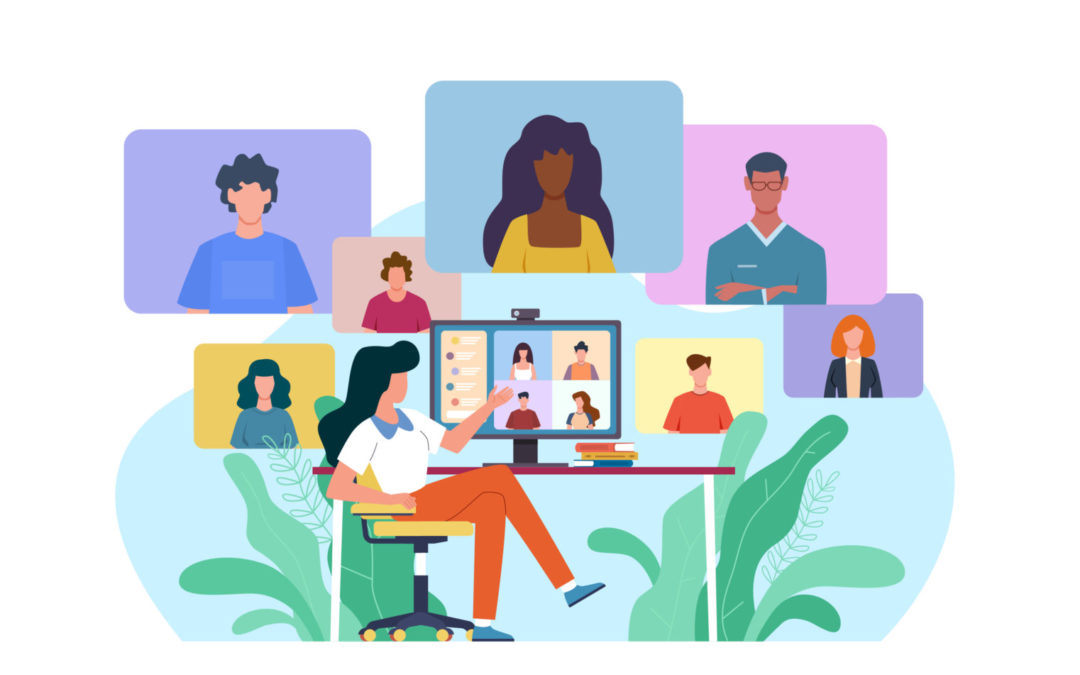
by American Business Women's Association | Oct 21, 2022 | Blog
We live in an upside world where the old rules no longer apply. Many call it a VUCA world – volatile, uncertain, complex and ambiguous. Mass consumerism has been replaced by a new consumption paradigm as people are driven by new essentialism where things matter less and relationships, experiences and self-being dominate all. In this new world, workers are restless, customers fickle, investors skittish, and the public has an appetite to cancel. In order to rally everyone together to stand behind a company and its path during all the ups and downs, leaders need to draw upon emotions as rationality will not carry the day. They have one tool at their disposal to do this delicate work – the brand.
Although often associated with marketing, brands are actually cultural icons that symbolically carry meaning. In just a nano second, they evoke common immediate meaning and emotions across all people. Think BMW, John Deere, Chanel, Apple and American Express. In a world where everything is uncertain, brands can be trusted to stand true. Now, if you don’t have a brand, you can build one. Anyone can. It takes commitment to people, to tell their story and represent their interests with your brand, not your own. If you create a brand that represents the highest common denominator between your people (customers, employees, investors) and your products/services, then you can forge an enduring powerful partnership that will yield surprising dividends for your business. It all begins with understanding the basics of what a brand really means for a business.
ONE – A Brand Resides in the Mind not in a Logo
Although expressed in a logo and a tagline, a brand is actually a mental construct that gets into the mind and lives in the memory of people. Branding is the process of creating the brand in the minds of people. It is typically done by creating things and experiences that “express” the brand such as marketing materials and product design. Brands also live in the culture. Powerful brands like Nike become social concepts and exist in the culture where they continually give people cues and establish the brand as a part of society.
TWO – Brands Set Meaning
Brands give meaning to products. Is an anti-lock braking system (ABS) a breakthrough in performance (BMW) or safety (Volvo)? That depends on the brand. The brand is a mental lens that provides immediate meaning. A Snickers bar is a snack. Tiffany means luxury taste and quality. Apple is about unleashing creativity while IBM is about improving productivity. The brand provides context which tells people why a product is important to them.
THREE – Brands Carry Emotional Power
Like great art, brands are designed to elicit a response, both emotional and rational. Like art they can enchant and often captivate people which creates desire. Marlboro was the first filter-tipped cigarette and was initially launched as a woman’s cigarette which failed. The same product was re-branded as the ultimate masculine smoke and with the swagger of the Marlboro man still remains one of the most powerful brands in the world. Powerful brands are mythologies that evoke emotions that swell to desire.
FOUR – Brands are Fiction Not Fact
Branding is poetry not journalism. Messaging matrixes and value propositions belong to marketers and are fact-based. Branding is another world that is concept-based. Branding brings out the big gun – an idea. A powerful, transcendent, mind-tweaking idea designed to engage the mind and heart at another level. The idea is what catalyzes new behavior and thinking. When Tide gets clothes clean, it means that Mom and Dad are good parents and conveys that message. The Home Depot is a large hardware store, but the brand makes it a Home Center for any current and aspiring do-it-yourselfer.
FIVE – Brands Defy Logic
When you have a powerful brand, you’ll be surprised by what it can do. You will see strong conviction and commitment across employees, customers and investors despite challenges. People tend to defend the brands they love and stay loyal against all odds – better alternatives, cheaper alternatives, easier alternatives. To achieve that kind of priceless cohesion, you have to build and continually maintain the brand campfire – and make it into a bonfire for the whole world to see. At John Deere, they say people bleed green because the brand is so deep.
SIX – Brands Deliver Business Value Multiple Ways
Because powerful brands are sticky, they have the ability to build a moat around the business. Customers remain loyal even in the face of superior performing or lower priced competitors. People forgive and forget product and corporate errors which mitigates losses. People are more willing to try new products, services and experiences from brands they love which accelerates sales. If you have a vision to build an empire, but a brand to amplify the upside and mitigate the downside.
Many corporate executives view the brand as simply a marketing asset. Others like Steve Jobs, Bill Gates, Richard Branson and Elon Musk view it as a corporate asset, part of the business strategy. Once built, a powerful brand can be used to wield influence in many circumstances from the Main Street to Wall Street to Capitol Hill. While products and executives may come and go within a company, the brand can endure forever – as long as it is well maintained.
In a world of fake news where people are becoming increasingly unmoored and where constant shocks and disruptions seem to prevent ‘normal’ from ever being a reality, brands are a reassuring presence that people can depend on. Powerful brands nurture, the people that come to work, buy products and invest in companies. Business always comes down to connecting with people on a human level. Powerful brands are creative concepts that stimulate the imagination and emotions in ways that most CEOs cannot. With a powerful brand, the CEO has a tool to open minds, raise hearts, command attention, bring everyone together and protect the business again in a volatile, uncertain, complex and ambiguous world.
About the Author: Jane Cavalier, CEO and Founder of BrightMark Consulting, is a nationally recognized brand strategist, board member, blogger and author of bestselling business book The Enchanted Brand (Amazon). She helps organizations conquer a changing world with powerful brands and reputations. Recognized for creating breakout brands like Snapple and Qwest, Jane has worked with over 100 organizations including American Express, Johnson & Johnson, ExxonMobil and the U.S. Navy. For more information, visit www.brightmarkconsulting.com.

by American Business Women's Association | Oct 14, 2022 | Blog, Uncategorized
No single person, no matter how intelligent or experienced, can understand everything there is to know about a given job. Questions will come up, and when they do, the individual – whether a software developer, project manager, sales engineer – or any other title, needs to have a handle on the specific support that is needed, and how to ask for it.
With more people working remotely than ever before, this topic is emerging as a persistent issue. This is particularly true in fields like tech, in which teams must understand how to quickly resolve network and other systemic breakdowns and problems. Here are some ideas how to overcome lack of on-the-job support and seek help:
- Be sure to reach out to the right person. Many times, unhelpful or unsupportive people are acting out of lack of knowledge. Before you text, email, or phone, consider if you are contacting the correct individual. This person may have taken a different position in the company and is no longer current on the issues you need. If you require specific examples of what to do, reach out to someone good at providing practical advice – not someone who offers platitudes like, “You’re smart, you’ll figure it out.”
- Understand the support you need and ask for it Make it clear to colleagues and supervisors alike where you need help. Do you need support on a particular problem? Do you require assistance to better understand the project in its entirety? Perhaps you need to just grasp your specific role in it? Maybe you need greater flexibility to make a deadline. What is it, exactly, that you need? It’s not a good idea to assume that people will automatically know. Tell them.
- Set realistic expectations of others. Many times, people are weathering enough challenges of their own to help out. They may not have the time or resources to be as supportive as you’d like them to be. Is it possible you’re asking for too much? This is where realistic expectations come in. Be sure you’re asking for assistance, nothing more. If your requests are excessive, you will need to start giving back before you can expect any support in return.
- Lack of support often means lack of communication. It can prove difficult to obtain the help you need if there is a big gap in communication. An outgoing person may be happy to talk at length about your problem. But if you assimilate information better by watching a video that explains the issue, contact a colleague who will use a platform like this to help. You may not “get” what the other person is saying or the individual you’re asking might not understand your request because of a communication gap.
- Network, network, network. You can never know too many people! If a trusted colleague quits to take another job with another company and you’ve relied on him exclusively, what then? The plain fact is that people move away, retire, etc. As noted earlier, no single person knows everything. A network of trusted friends, coworkers, mentors, and the like can help in areas where help and support may be lacking. A change of perspective may be what you need instead of relying on the same person.
- Finally, be sure you are willing to accept criticism. We all like to give good advice but we are sometimes awful at accepting the advice of others as it forces us to admit our weaknesses. It’s normal for an individual to think they know more than they actually do. Remember, there is a reason you asked for assistance. Don’t take their suggestion personally. Consider if doing what the person advises will help you professionally. If it will, do it!
In conclusion, never assume a colleague, supervisor or manager understands what you are asking. Don’t rely on a single coworker for assistance and be sure to reach out to the person who can address your problem best. Good luck!
About the Author, Susanne Tedrick
Susanne Tedrick is an infrastructure specialist for Azure, Microsoft’s cloud computing platform. In her work, Susanne helps her clients address needs and challenges surrounding cloud adoption, cost optimization and migration. Susanne is the author of the critically acclaimed “Women of Color in Tech” and the upcoming “Innovating For Diversity”. For more information, please visit: www.SusanneTedrick.com.

by Rene Street | Aug 28, 2022 | Uncategorized
Four Strategies to Start Using Now
“I learned so much during orientation. It’s too bad I won’t use most of it for six months. I took some notes, but I’m sure I won’t remember half of what they told me to do.”
“I’m overwhelmed. I learned a new piece of equipment today. The person showing me what to do knew everything. The problem I had was the deep dives. He spent so much time on troubleshooting techniques. It was just too much for my first day.”
“I can follow the steps, but I have no idea why I’m doing what I’m doing. I sort of feel like a trained monkey. I hope nothing goes wrong because I will have no clue how to fix it if something does.
Despite our best efforts, it’s not as easy as it looks to get the training equation right. We train too early, we train too much, or we make a host of other errors. While some of us learn from our mistakes, many of us practice a cycle of rinse and repeat as we make the same blunders year after year. The good news is it doesn’t have to be this way. With some careful planning and follow through, you can avoid problems many people will encounter again and again.
Strategy One: Keep Training Relevant and Immediately Applicable
Countless onboarding programs attempt to teach everything a person would ever want to know or need to know about a job in the first few hours, days, or weeks. The information is important, but it has no immediate value. Subsequently, learners become overwhelmed in class, and then they don’t have opportunities to apply or reinforce what they’ve learned for months or even years.
Good training designers know the value of careful pacing, and they practice just-in-time training when they can. Ask yourself, what does my learner need to be successful in the first day, the first week, and the first month? Teach to those needs as much as possible, and save the more in-depth information for a more appropriate time. What do you need to prioritize?
Strategy Two: Connect to Why Again and Again
When people don’t know why they are doing something, they don’t understand the big picture. While they get the process at a surface level, their limited understanding potentially keeps them from following procedures later.
For example, if someone is learning how to use a print/copier/scanner/fax machine and part of the process is putting the guard up on the paper tray with jobs over 100 sheets, without explaining as to why that’s important to do, that learner might take it upon himself to skip that step back on the job. Only when papers are scattered all over the floor and have to be re-collated does the learning know the importance of raising the guard.
Great trainers make connections. They repeatedly explain why they’re doing what they’re doing, why procedures are written as they are, and so forth. Are you connecting the dots as well as you should, or could you do a better job?
Strategy Three: Use Multiple Channels to Cement Learning
I showed her how to do it, she did it, and now she’s trained. Maybe that’s true for the simple stuff, but for the complex processes and procedures, multi-channel encoding reigns supreme.
For example, show learners in real-time how to complete a process. Then do it again, at the same time providing a narration track while the learner takes notes. Next, have the learner read aloud the notes she’s taken. Finally, have the learner demonstrate the procedure.
The multi-channel approach allows learners to see, to hear, to write, to speak, and to do whatever process they are learning. Depending on the learner, some senses may be more powerful than others. And in rare cases where there is no preference, repetition wins the day. What can you do differently to engage more senses?
Strategy Four: Teach with Reference Tools
- It’s one thing to conquer a task during class or one-on-one job coaching, but it’s entirely another to reproduce those results on the job.
- People who have mastered the training function know to develop and teach reference tools in addition to processes themselves.
- Ask yourself what kinds of support you need to develop. Decide where you need to incorporate them in your training plans. Those who learn how to solve problems themselves are worth their weight in gold. In addition to strong productivity, these people are also usually happier and more motivated than those who don’t have the tools to stand on their own feet.
Four strategies and none hard: make training relevant, connecting to why, repeating information using different channels, and incorporating the tools learners should use to solve problems back on the job. If done deliberately and with routine, you will almost certainly get a good result.
About the Author
Kate Zabriskie is the president of Business Training Works, Inc., a Maryland-based talent development firm. She and her team provide onsite, virtual, and online soft-skills training courses and workshops to clients in the United States and internationally. For more information, visit www.businesstrainingworks.com.






